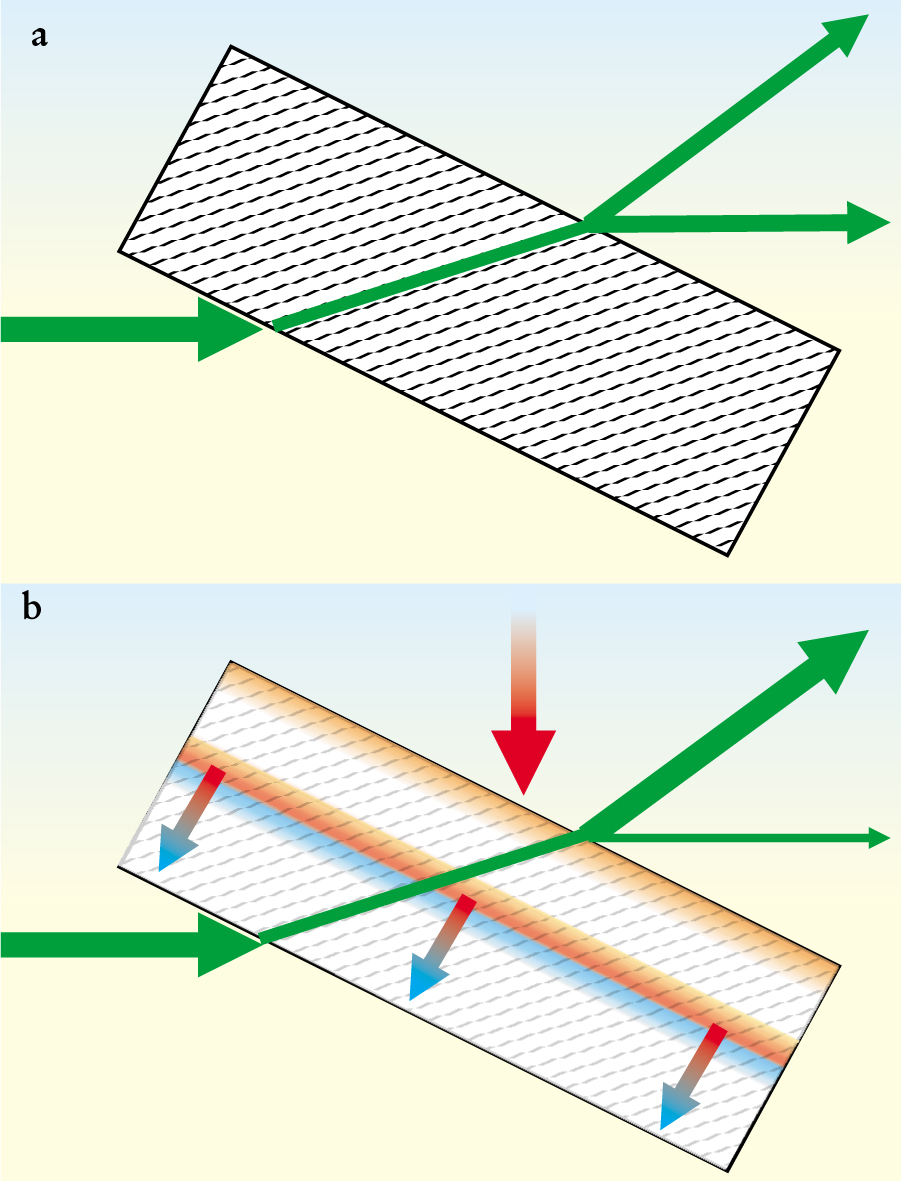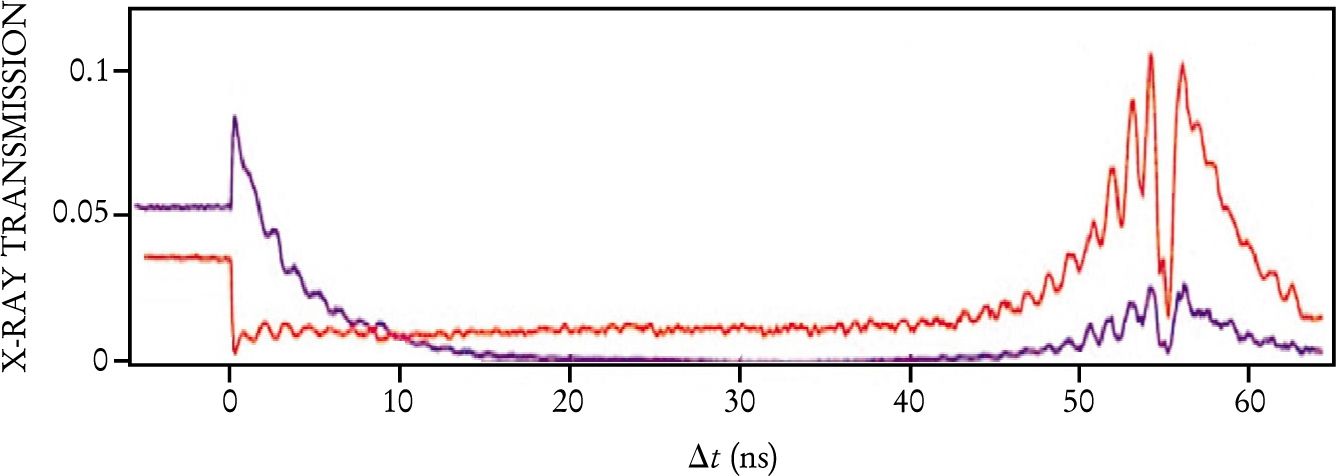Ultrashort Laser Pulses Can Control X-Ray Switch
DOI: 10.1063/1.1461320
In the molecular world of chemical reactions and conformational changes in biological and other molecules, events often happen on time scales from hundreds to thousands of femtoseconds—the typical period of molecular vibrations. Femtochemistry (described in Physics Today, December 1999, page 19
Obtaining probes of appropriate wavelength, duration, and intensity is no easy matter, however. Laser-produced plasmas can generate sufficiently short bursts of x rays, but the bursts aren’t highly collimated and have relatively low flux. Synchrotron sources, in contrast, produce trains of pulses that are tunable and have high brightness but, with durations of 10—100 picoseconds, are orders of magnitude too long.
Recently, a group of researchers from the University of Michigan, led by David Reis, Philip Bucksbaum, Roy Clarke, and Roberto Merlin, has demonstrated a method of coherently modulating synchrotron x-ray pulses. Their technique might be scaled to produce subpicosecond switching. 1 “The preliminary experiments on this ultrafast switch are very promising,” comments Jean-Claude Kieffer of the University of Quebec.
Exploiting the Borrmann effect
Key to the Michigan technique is the anomalous transmission of x rays through a crystal—the Borrmann effect. Usually, x rays are strongly attenuated in solids. But if properly oriented, a crystal’s lattice planes can act as a waveguide: With the nodes of the x-ray electric field along the occupied lattice sites, attenuation is greatly reduced.
X rays incident on an appropriately oriented crystal generate a superposition of the anomalously transmitted mode and an orthogonal mode, transversely shifted by a quarter wavelength so that the field’s anti-nodes are along the occupied lattice sites. For sufficiently thick crystals, this second mode is quickly absorbed, and only the first mode survives to reach the exit face of the crystal. There, it emerges as a forward beam, parallel to the incident direction, and a deflected beam of nearly equal intensity, as shown in figure 1. (This behavior underlies x-ray transmission interferometers, described in Physics Today, July 2000, page 23

Figure 1. Laser-induced x-ray switch. (a) When an x-ray pulse (green) is incident on an undisturbed germanium crystal, the crystal’s lattice planes (dashed lines) can serve as waveguides, steering the pulse through to the exit face, where it emerges into a forward beam (parallel to the incident beam) and a deflected beam of nearly equal intensity. (b) A femtosecond laser pulse (red) heats the exit face of the Ge crystal, generating a thin acoustic front of compression (blue) and expansion (red) that travels through the crystal. The acoustic wave modulates the intensities of the forward and deflected x-ray beams.
(Courtesy of Matt DeCamp.)

Working at the MHATT-CAT beam line at the Advanced Photon Source at Argonne National Laboratory, the Michigan group used 70-fs laser pulses to locally heat a germanium crystal. The resulting rapid thermal expansion triggered a narrow acoustic pulse that propagated through the crystal. The effect of the pulse, explains Reis, was essentially to split the crystal into two, with the compression and expansion regions of the acoustic wave defining a moving boundary between them (see figure 1).
The Borrmann effect is very sensitive to lattice distortions. Thus, when an x-ray pulse traveling through the Michigan crystal encountered the acoustic wave, the x-ray energy was redistributed between the two transmission modes. If this encounter occurred near the exit face of the crystal, both modes survived to leave the crystal. And because the modes travel at different phase velocities, the researchers could alter the superposition of modes at the exit face by controlling where in the crystal the x-ray pulse passes the acoustic wave. In that way, they could preferentially steer the x rays emerging from the crystal into the forward or deflected beam, as shown in figure 2.

Figure 2. Diffraction of x rays into the forward (blue) and deflected (red) beams can be controlled by adjusting the time Δt between when the laser pulse and the x-ray pulse arrive at the germanium crystal.
(Adapted from ref. 1.)

This technique, limited by the sound of the acoustic wave, currently gives control on time scales comparable to the synchrotron radiation pulse widths. With such switching speeds, controllable x-ray beamsplitters that can isolate a single pulse of synchrotron radiation are possible, but the method isn’t fast enough for some time-resolved experiments. Reis and coworkers are optimistic, though, that by generating optical phonons using similar techniques, they will be able to achieve subpicosecond switching of the x-ray pulses.
Other techniques
Other approaches for producing femtosecond bursts of x rays for time-resolved x-ray studies are also being pursued. Among the most widely used is that of laser-produced plasmas. An intense ultrashort laser pulse can evaporate atoms at the surface of a solid. The resulting highly ionized plasma emits a burst of x rays, predominantly at discrete frequencies (the Kα lines). Bursts as short as 300 fs are readily achievable. Using this approach, Jeff Squier (University of California, San Diego) and colleagues
2
have observed simultaneous structural and electrical phase transitions in vanadium oxide (see Physics Today, January 2002, page 9
Robert Schoenlein and colleagues at Lawrence Berkeley National Laboratory have demonstrated a different method for obtaining short x-ray pulses at synchrotrons. They used a femtosecond laser copropagating with an electron bunch at the Advanced Light Source at LBL to give a kick in energy to a slice of the electron bunch. As the electrons proceeded around the storage ring, that slice became spatially separated from the rest of the bunch. The radiation from the slice could consequently be isolated, producing an x-ray pulse 300 fs long. Additionally, the extraction of the electron slice created an ultrashort hole in the radiation emitted from the remaining electrons. 3
Planned advances in synchrotron beam lines will create shorter electron bunches and, therefore, shorter pulses of emitted radiation. The upgrades will also increase the flux and brightness. Subpicosecond x-ray pulses are part of the design specifications for x-ray free electron lasers proposed for the fourth-generation TESLA collider at the German Electron Synchrotron (DESY) and for the Linac Coherent Light Source at SLAC (see the article by William Colson, Erik Johnson, Michael Kelley, and Alan Schwettman in Physics Today, January 2002, page 35
References
1. M. F. DeCamp, D. A. Reis, P. H. Bucksbaum, B. Adams, J. M. Caraher, R. Clarke, C. W. S. Conover, E. M. Dufresne, R. Merlin, V. Stoica, J. K. Wahlstrand, Nature 413, 825 (2001).https://doi.org/10.1038/35101560
2. A. Cavalleri, Cs. Tóth, C. W. Siders, J. A. Squier, F. Ráksi, P. Forget, J. C. Kieffer, Phys. Rev. Lett. 87, 237401 (2001).https://doi.org/10.1103/PhysRevLett.87.237401
3. R. W. Schoenlein, S. Chattopadhyay, H. H. W. Chong, T. E. Glover, P. A. Heimann, C. V. Shank, A. A. Zholents, M. S. Zolotorev, Science 287, 2237 (2000).https://doi.org/10.1126/science.287.5461.2237

